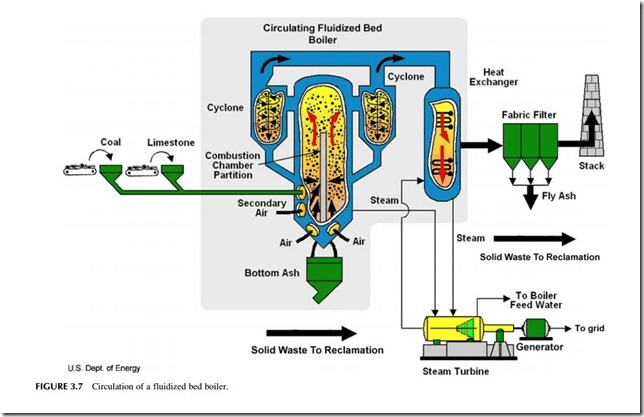FLUIDIZED BED COMBUSTION
While the pulverized coal-fired boiler represents the most efficient type of coal- fired power plant, there are alternatives. One of these is the fluidized bed boiler. This type of combustion system is capable of burning a much wider range of fuels than a PC plant. It operates at a lower temperature, making the production of nitrogen oxide less of a problem, and it can also incorporate sulfur capture within the combustion chamber, leading in principle at least to easier emission control.
The concept behind the fluidized bed is simple: to create a solid-state reactor that mimics liquid-phase reactors. If a layer of sand, finely ground coal, or another fine solid material is placed in a container and high-pressure air is blown through it from below, the particles, provided they are small enough, become entrained in the air and form a floating (i.e., fluidized) bed of solid particles above the bottom of the container. This bed of solid particles now behaves like a liquid in which the constituent particles constantly move to and from and collide with one another like the molecules in a liquid. As a type of reactor, this offers some significant advantages because it encourages much more rapid and thorough reaction between the particles within the bed or between the particles and air in the case of combustion.
The fluidized bed was used first in the process industries to enhance the efficiency of chemical reactions between solids by simulating conditions of a liquid-phase reaction and as a simple method of reducing emissions from industrial plants. Only later was its application for power generation recognized. Its use is now widespread. The fluidized bed can burn a variety of coals and other poorer fuels, such as peat, coal-cleaning waste, petroleum coke, wood, and other biomass. See Figure 3.7 for a diagram of its circulation.
A fluidized bed used for power generation contains only around 5% coal or fuel within the actual bed. The remainder of the bed is primarily an inert material, such as ash or sand. The temperature in a fluidized bed is around 950 oC, significantly lower than the temperature in the heart of a pulverized coal furnace. This low temperature helps minimize the production of nitrogen oxide. A reactant such as limestone can also be added to the bed to capture sulfur, reducing the amount of sulfur dioxide released into the exhaust gas. One further advantage of the fluidized bed is that boiler pipes can be immersed in the bed itself, allowing extremely efficient heat capture (but also exposing the pipes to potentially high levels of erosion).
There are three primary designs for fluidized bed power plants in use. The simplest, called a bubbling bed plant, is essentially a conventional boiler in which the combustion chamber has been replaced with a fluidized bed. Air is blown at relatively low velocity into the chamber from beneath the bed to maintain its fluid state and fuel introduced from above. Ash is removed from below, as in a PC plant, and additional, overfire air is blown in above the bed to complete the combustion process. Bubbling fluidized bed plants are often used in biomass plants.
The second, more complex design is the circulating fluidized bed plant. In this type of fluidized bed the particles are fluidized at high speed by using high- velocity air and a cycling fluidized mass is created. The high-speed particles within this type of plant pass up out of the combustion chamber and are then recovered and recirculated by passing the flow of flue gases and particles through a cyclone filter that returns the particles to the bed while allowing the flue gases to flow onwards. Such plants provide good mixing and long res- idence times for particles so that emission control using additives in the bed can be more effective. They are also capable of burning higher calorific value fuels such as anthracite, which would be more difficult to combust completely in the bubbling bed reactor.
The circulating bed can remove 90–95% of the sulfur from the coal while the bubbling bed can achieve between 70% and 90% removal. Maximum energy conversion efficiency is 43%, similar to that of a traditional pulverized coal plant. However, such high efficiencies can only be achieved with larger plants that can employ larger, and generally more efficient, steam turbines under optimum steam conditions. Advanced fluidized bed plants are built with supercritical boilers to achieve these high conversion efficiencies.
A third type of fluidized bed design, called the pressurized fluidized bed (Figure 3.8), was developed in the late 1980s and the first demonstration plants employing this technology were constructed in the mid-1990s. The pressurized bed is like a bubbling bed, but operates at a pressure between 5 atmospheres and 20 atmospheres. This allows higher overall efficiency to be achieved.
Operation under high pressure means that the flue gases exiting the boiler can be passed through a gas turbine to capture additional energy for power generation. This is in addition to the power generated by the traditional steam cycle.
In principle, a pressurized fluidized bed power plant is capable of a conversion efficiency of 44–45%, but in practice they have not achieved this level. The largest pressurized fluidized bed power plant in operation is a 360 MW unit in Japan. This plant, with a supercritical boiler, has a claimed efficiency of 42%.
Although commercial fluidized bed power plants with capacities of over 400 MW are available, the units have not proved as efficient as supercritical PC power plants for coal combustion. Their sulfur and nitrogen oxide emis- sions, though lower than from an unmitigated PC power plant, are often too high to meet statutory regulations and additional measures are required to control the emissions. However, the plants can burn a variety of fuels other than coal. This has made them attractive for a range of projects where low-grade fuels, fuel waste, or biomass are to be burned.

